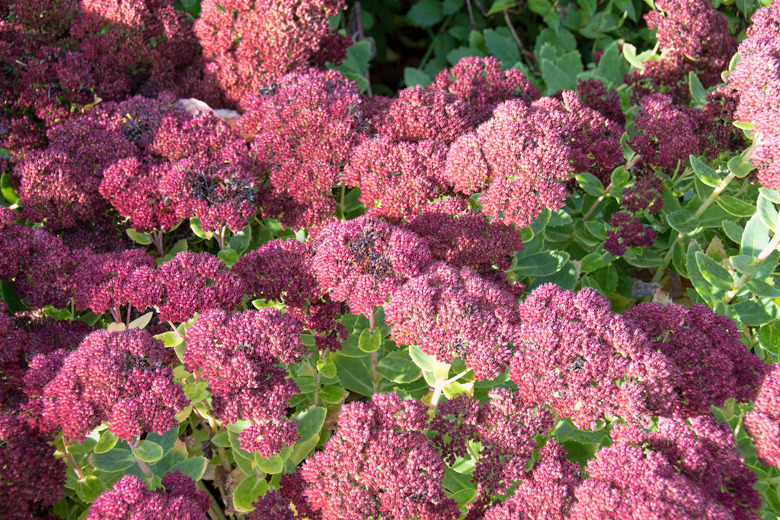How To Prune Sedum
Sedum plants are easy-care, drought-tolerant, pollinator-friendly succulents that produce clusters of star-shaped flowers. Some sedums are low-growing, while others are tall, and they offer a variety of foliage color and flower color. One popular type is upright sedum (including Hylotelephium spp., Sedum erythrostictum, and Sedum pulchellum), which forms tall, standing clumps with tight masses of tiny flowers in large flowerheads. The size, shape, and appealing blossoms of these upright stonecrops make them top choices for rock garden borders and pollinator gardens. Tall sedum can be pruned to the ground in autumn, but many gardeners opt to leave the stalks in place during the cold months for winter interest.
Learn more about when and how to prune your upright sedum.
Types of Upright Sedums
Types of Upright Sedums
Sedum is a genus of drought-resistant, low-maintenance perennial plants with fleshy leaves. A common name for these plants is stonecrop. This is in reference to the fact that in the wild, they grow on rocks or stony ledges. Sedums come in many shapes and sizes, from low-growing ground-cover succulents like Dragon's Blood sedum (Sedum spurium 'Schorbuser Blut'), which is no taller than 6 inches, to upright sedums that stand tall to 3 feet or more. Most grow well on poor soil as long as it is well-draining, and they like a full-sun to partial-shade location.
Upright sedums form tall, upright clumps with classic succulent leaves. Their stems are topped with large, flattened flower heads in late summer, offering tight masses of tiny flowers. Their height and attractive flowers make them impressive garden features that work well in border gardens or pollinator gardens. Although some upright sedums were reclassified to the genus, Hylotelephium, in recent years, all are still commonly referred to as "sedum."
There are many upright sedums from which to choose. Some to consider include:
- Autumn Joy (Hylotelephium 'Herbstfreude'): A cross between a species of sedum (Sedum telephium) and a species of ice plant (Hylotelephium spectabile); vivid pink flowers in summer and fall.
- Purple Emperor (Sedum 'Purple Emperor'): A hybrid perennial sedum that typically grows in upright clumps to 15 inches tall with tiny, starlike, dusky
pinkish-purple flowers that bloom with large, flattened heads with dark purple, fleshy, succulent leaves; long
midsummer to early fall bloom. - Frosty Morn (Sedum erythrostictum 'Frosty Morn'): This upright sedum stays at 12 inches or less and has white blooms (typically in warmer climates) or light-pink blooms (typically in cooler climates). An outstanding feature of this cultivar is its striking variegated cream-and-green foliage.
Pruning Sedum in Fall
Pruning Sedum in Fall
Upright sedums stand tall with gray-green, succulentlike fleshy leaves on standing stems topped with clusters of tiny starry flowers. These flowers, in white, pink, or red, are one of the most attractive features of the plant and attract butterflies and bees. They change in color as they mature. The popular Autumn Joy sedum cultivar, for example, has 3- to 6-inch clusters of blossoms that open pink but gradually change to deep rose in early fall and then turn bronze red at maturity. The flowering plant blooms in midsummer through late autumn.
The blossoms die with the first hard frost. At this time, the sedums go into dormancy. However, sedum plants are perennials, some hardy to USDA plant hardiness zones 3 to 9. When growing upright sedums in cold zones with long winters, including zone 5 and below, you will do best to plant them in full sun rather than partial shade to improve their overwintering capability.
All upright sedums can be cut back to the ground after the flowers fade. This is recommended in regions that are so cold that the plants die back. In warmer-winter areas, it is optional. Pruning back makes room for new spring growth.
Pruning Sedum in Spring
Pruning Sedum in Spring
Many gardeners in warmer-winter climates prefer to leave the upright sedums in place all winter long. The flowers gradually fade in color. Topped with the dried flower heads, upright sedums have an unusual visual appeal that adds winter interest to the garden during the cold season. In addition, the dried flowers hold seeds that provide a winter food source for some wild birds.
If plants are left standing to overwinter, they can be pruned back to the ground in early spring before new growth emerges. This tidies the garden and makes way for new growth, but it is optional.
Pruning Sedum for Shape
Pruning Sedum for Shape
Anyone planting sedums should check the mature size of the plants when selecting a site. While some plants are short and considered ground cover, upright sedums, like Autumn Joy stonecrop, form clumps that can reach 2 feet tall and wide. Selecting a size that works in your space reduces pruning requirements.
If you have planted sedums that are crowding out other plants in the area, upright sedum varieties can be pinched back in spring to promote more compact growth. Simply pinch off stems just above a leaf node.
Need to see the sedum pruning process visually? Here's a video tutorial from NorthCoastGardening:
